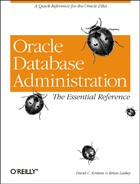Name
ALTER SNAPSHOT
Synopsis
ALTER SNAPSHOT [schema.]snapshot_name[PCTFREEinteger] [PCTUSEDinteger] [INITRANSinteger] [MAXTRANSinteger] [LOGGING | NOLOGGING] [CACHE | NOCACHE] [STORAGE ( [NEXTinteger[K | M] ] [MAXEXTENTS {integer| UNLIMITED} ] [PCTINCREASEinteger] [FREELISTSinteger] [FREELIST GROUPSinteger] ] ) ] [PARALLEL ( {DEGREE {integer| DEFAULT} | INSTANCES {integer| DEFAULT} } ) ] [NOPARALLEL] [USING INDEX [PCTFREEinteger] [INITRANSinteger] [MAXTRANSinteger] [LOGGING | NOLOGGING] [STORAGE ( [INITIALinteger[K | M] ] [NEXTinteger[K | M] ] [MINEXTENTSinteger] [MAXEXTENTS {integer| UNLIMITED} ] [PCTINCREASEinteger] [FREELISTSinteger] [FREELIST GROUPSinteger] ) ] ] [REFRESH [FAST | COMPLETE | FORCE] [START WITHdate] [NEXTdate] [WITH PRIMARY KEY] [USING DEFAULT [MASTER | LOCAL ] ROLLBACK SEGMENT] | [USING [MASTER | LOCAL] ROLLBACK SEGMENTrollback_segment] ]
Changes the storage characteristics or automatic refresh characteristics of a snapshot (snapshot_name).
Keywords
- PCTFREE
Specifies the percentage of space to be reserved in each data block for future updates to rows contained in that block. Valid values are - 99, and the default value is 10.
- PCTUSED
Specifies the minimum percentage of space that will be maintained as used in each data block. Valid values are 1- 99, and the default value is 40.
- INITRANS
Specifies the initial number of transaction entries allocated to each block.
- MAXTRANS
Specifies the maximum number of transaction entries allocated to each block.
- LOGGING
Specifies that the operation is to be logged to the redo logs.
- NOLOGGING
Specifies that nothing is to be written to the redo logs for this operation.
- CACHE
Specifies how many sequence numbers Oracle will pregenerate and keep in memory. Note that when the database is shut down, unused sequence numbers stored in cache will be lost. The default is 20.
- NOCACHE
Specifies that no sequence numbers are pregenerated to memory.
- STORAGE
Specifies the physical characteristics of the snapshot as follows:
- NEXT
Specifies the size of the next extent in bytes, kilobytes, or megabytes. If the value is not a multiple of the database blocksize, it will be rounded up to a multiple of the database blocksize.
- MAXEXTENTS
Specifies the maximum number of extents that may be allocated for this snapshot. The default will vary according to the database blocksize. Specify UNLIMITED for unlimited expansion.
- PCTINCREASE
Specifies the percentage by which each extent will grow over the previous extent. The default is 50, which means that each extent will be one-and-one-half times larger than the previous extent.
- FREELISTS
Specifies the number of free lists contained in each freelist group in this snapshot. The default is 1, and the maximum depends on the database blocksize.
- FREELIST GROUPS
Specifies the number of groups of free lists for this snapshot. The default is 1. This parameter should be used only with the Parallel Server option running in parallel mode.
- PARALLEL
Specifies the level of parallelism to be supported, based on the following parameters:
- DEGREE
Specifies the degree of parallelism. An integer value specifies how many slave processes can be used. Specify DEFAULT to use the default value for the tablespace.
- INSTANCES
Specifies the number of instances that can be used to execute slave processes. Specify DEFAULT to use the default value specified for the tablespace.
- NOPARALLEL
Specifies that no parallel processing will be supported for the snapshot.
- USING INDEX
Changes the value of the PCTFREE, INITRANS, MAXTRANS, and STORAGE parameters for the index Oracle uses to maintain the snapshot’s data. If the index is being created, you can also specify:
- INITIAL
Specifies the size of the first extent for this snapshot in bytes, kilobytes, or megabytes. If this value is not a multiple of the database blocksize, it will be rounded up to a multiple of the database blocksize.
- MINEXTENTS
Specifies the number of extents to be allocated when this snapshot is created. The minimum and default value is 1.
- REFRESH
Specifies the mode and times for automatic refreshes. FAST means use the snapshot log associated with the master table. COMPLETE means refresh by reexecuting the snapshot’s query. FORCE is the default, and means that Oracle will either decide that a FAST refresh is possible or do a COMPLETE refresh.
- USING DEFAULT ROLLBACK SEGMENT
Specifies the rollback segment to be used as a default if a rollback segment is not explicitly supplied. Select either MASTER (use the default rollback segment at the remote master for the individual snapshot) or LOCAL (use the default rollback segment for the local refresh group that contains the snapshot).
- USING ROLLBACK SEGMENT rollback_segment
Specifies the rollback segment to use when refreshing the snapshot. Specify either MASTER (the rollback segment to be used at the remote master for the individual snapshot) or LOCAL (specifies the rollback segment to be used for the local refresh group that contains the snapshot).
